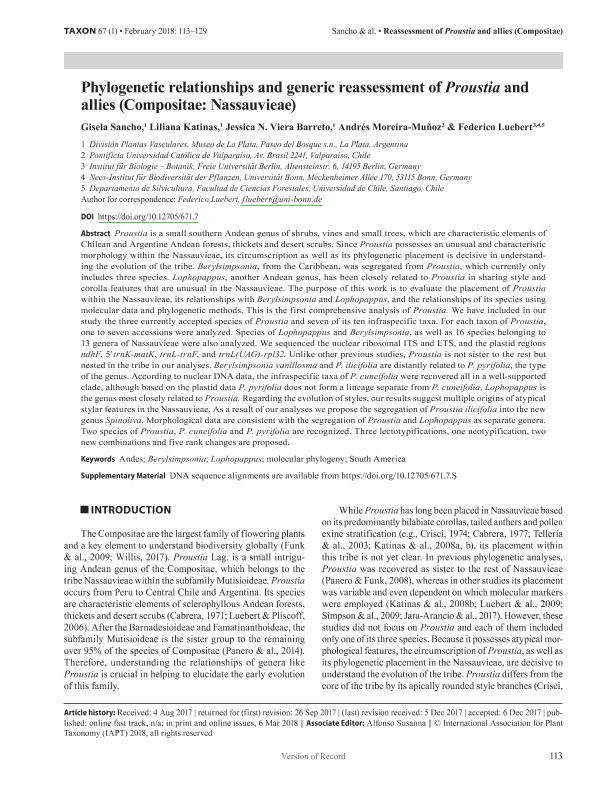Artículo
Phylogenetic relationships and generic reassessment of proustia and allies (Compositae: Nassauvieae)
Sancho, Gisela ; Katinas, Liliana
; Katinas, Liliana ; Viera Barreto, Jessica Noelia
; Viera Barreto, Jessica Noelia ; Moreira Muñoz, Andrés Sergio; Luebert, Federico
; Moreira Muñoz, Andrés Sergio; Luebert, Federico
 ; Katinas, Liliana
; Katinas, Liliana ; Viera Barreto, Jessica Noelia
; Viera Barreto, Jessica Noelia ; Moreira Muñoz, Andrés Sergio; Luebert, Federico
; Moreira Muñoz, Andrés Sergio; Luebert, Federico
Fecha de publicación:
03/2018
Editorial:
International Association for Plant Taxonomy
Revista:
Taxon
ISSN:
0040-0262
Idioma:
Inglés
Tipo de recurso:
Artículo publicado
Clasificación temática:
Resumen
Proustia is a small southern Andean genus of shrubs, vines and small trees, which are characteristic elements of Chilean and Argentine Andean forests, thickets and desert scrubs. Since Proustia possesses an unusual and characteristic morphology within the Nassauvieae, its circumscription as well as its phylogenetic placement is decisive in understanding the evolution of the tribe. Berylsimpsonia, from the Caribbean, was segregated from Proustia, which currently only includes three species. Lophopappus, another Andean genus, has been closely related to Proustia in sharing style and corolla features that are unusual in the Nassauvieae. The purpose of this work is to evaluate the placement of Proustia within the Nassauvieae, its relationships with Berylsimpsonia and Lophopappus, and the relationships of its species using molecular data and phylogenetic methods. This is the first comprehensive analysis of Proustia. We have included in our study the three currently accepted species of Proustia and seven of its ten infraspecific taxa. For each taxon of Proustia, one to seven accessions were analyzed. Species of Lophopappus and Berylsimpsonia, as well as 16 species belonging to 13 genera of Nassauvieae were also analyzed. We sequenced the nuclear ribosomal ITS and ETS, and the plastid regions ndhF, 5′ trnK-matK, trnL-trnF, and trnL(UAG)-rpl32. Unlike other previous studies, Proustia is not sister to the rest but nested in the tribe in our analyses. Berylsimpsonia vanillosma and P. ilicifolia are distantly related to P. pyrifolia, the type of the genus. According to nuclear DNA data, the infraspecific taxa of P. cuneifolia were recovered all in a well-supported clade, although based on the plastid data P. pyrifolia does not form a lineage separate from P. cuneifolia. Lophopappus is the genus most closely related to Proustia. Regarding the evolution of styles, our results suggest multiple origins of atypical stylar features in the Nassauvieae. As a result of our analyses we propose the segregation of Proustia ilicifolia into the new genus Spinoliva. Morphological data are consistent with the segregation of Proustia and Lophopappus as separate genera. Two species of Proustia, P. cuneifolia and P. pyrifolia are recognized. Three lectotypifications, one neotypification, two new combinations and five rank changes are proposed.
Palabras clave:
ANDES
,
BERYLSIMPSONIA
,
LOPHOPAPPUS
,
MOLECULAR PHYLOGENY
,
SOUTH AMERICA
Archivos asociados
Licencia
Identificadores
Colecciones
Articulos(CCT - LA PLATA)
Articulos de CTRO.CIENTIFICO TECNOL.CONICET - LA PLATA
Articulos de CTRO.CIENTIFICO TECNOL.CONICET - LA PLATA
Citación
Sancho, Gisela; Katinas, Liliana; Viera Barreto, Jessica Noelia; Moreira Muñoz, Andrés Sergio; Luebert, Federico; Phylogenetic relationships and generic reassessment of proustia and allies (Compositae: Nassauvieae); International Association for Plant Taxonomy; Taxon; 67; 1; 3-2018; 113-129
Compartir
Altmétricas



